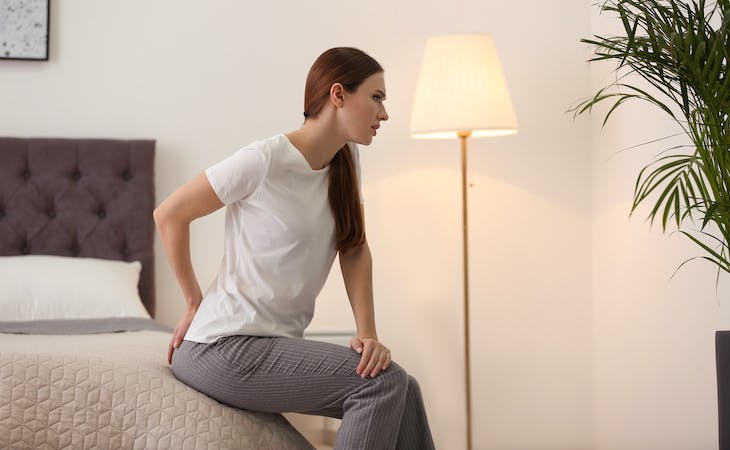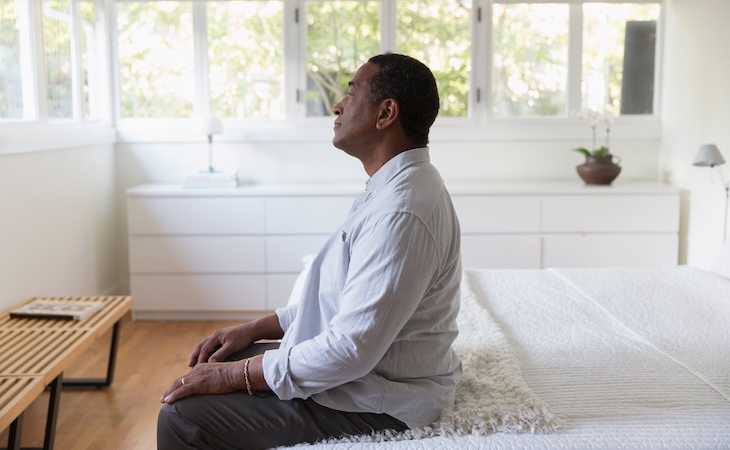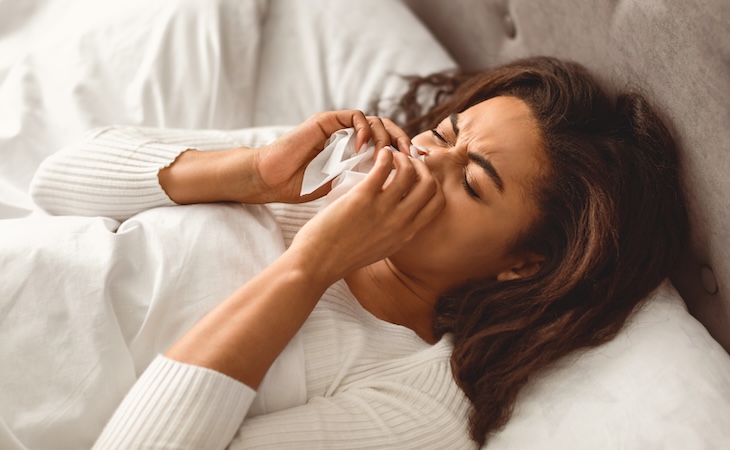About one in 20 Americans, and half of adults older than age 50, experience hemorrhoids, according to the National Institutes of Health. [1] Hemorrhoids can be incredibly painful, especially at night when you’re trying to sleep. This article will explore what hemorrhoids are and provide tips on the best ways to sleep with hemorrhoids.
What are hemorrhoids?
Hemorrhoids, also known as piles, are swollen and inflamed veins beneath the skin around your anus (external hemorrhoids) or inside your anus and lower rectum (internal hemorrhoids). [7, 8] Hemorrhoids can hurt, itch, burn, bleed, and be extremely uncomfortable. [5, 7]
The NIH says you’re more likely to get hemorrhoids if you:
- Strain during bowel movements
- Sit on the toilet for long periods
- Have chronic constipation or diarrhea
- Eat low-fiber foods
- Are older than age 50
- Are pregnant
- Often lift heavy objects [1]
How to sleep with hemorrhoids
As you might imagine, hemorrhoids can make it difficult to get a good night’s sleep. “Since the body automatically twists and turns during sleep, living with hemorrhoids leaves one with a sleep experience filled with extreme burning and pain,” says Christine Kingsley, advanced practice registered nurse and health and wellness director of the Connecticut-based Lung Institute. “At the end of the day, sleep itself is a struggle, causing one to not be able to maximize the health benefits of rest which ultimately leads to the decline of overall health.”
Here are tips from experts about how to sleep better with hemorrhoids:
Apply witch hazel ointment to the hemorrhoid
“As it is specifically designed for this purpose,” Kingsley says, “witch hazel ointment is the ideal treatment aid for relieving swelling hemorrhoids.” Its alcohol content dries out skin and fights bacteria. It also speeds up the healing process and prevents the existing swelling from getting worse. [7]
Take antibiotics prescribed by a physician (if recommended)
Kingsley says this will promote healing by blocking bacteria from recurring.
Sit on an ice pack
“The cold temperature offers instant pain relief,” Kingsley says. Don’t place the ice directly on your skin. Instead, wrap it in a paper towel or thin cloth. [4]
Reposition the hemorrhoid
If you have a thrombosed hemorrhoid—one in which there is a blood clot—Kingsley recommends gently repositioning it to spread the blood clot, which will lessen the pain. [3]
Stay hydrated
“Drinking plenty of water and other fluids can help soften your stools and make them easier to pass,” says Wendy Lord, registered dietitian nutritionist and medical content author at Health Reporter. “This can help prevent constipation and reduce the need to strain during bowel movements.” [6, 7]
Eat enough fiber during the day
Fruits and vegetables will keep your digestion running smoothly and avoid constipation, which worsens hemorrhoid pain, says Lord. [6, 7]
Apply a warm compress, or sit in a warm bath, before you go to sleep
This will help reduce pain and discomfort, says Lord. Take a full-body bath with Epsom salt or a sitz bath, which fits over your toilet and lets you soak the affected area without needing to take a full bath. [4, 10]
Sleep in a comfortable position
“Sleeping on your side or stomach can be more comfortable than sleeping on your back when you have thrombosed hemorrhoids,” says Lord. “However, it is advised to experiment with different positions to find one that is most comfortable for you.”
Avoid spicy foods before bedtime
They can make you need to visit the toilet, which is only going to irritate your hemorrhoid and keep you from sleeping. [6]
Place a pillow beneath or between your knees
Placing a pillow beneath or between your knees will reduce the pressure on your anal area and the weight of your abdomen on your pelvis.
Take an over-the-counter painkiller
Ibuprofen is an anti-inflammatory that reduces swelling and pain. Be cautious, though, because ibuprofen also can increase the risk that your hemorrhoids may bleed. Acetaminophen can blunt the pain sensation and let you sleep. Be sure to ask your doctor if you have any questions about painkillers. [9]
FAQs
How should you sleep with hemorrhoids?
Consider taking a warm bath before bedtime. Or use an ice pack to provide instant pain relief. Don’t wear clothing that fits tightly, especially underwear, as you want to allow air circulation around the affected area. Loose-fitting, breathable fabric is ideal. [4, 10] It’s important to sleep in a comfortable position that relieves pressure on the anal area.
What’s the best position to sleep in with hemorrhoids?
It’s not advisable to sleep on your back as that position increases pressure on your anal area and can irritate your hemorrhoid. Sleep instead on your side or on your stomach.
What helps hemorrhoid pain at night?
You can apply witch hazel ointment to the hemorrhoid to help relieve pain and swelling. Sitting on a pack of crushed ice offers instant pain relief. Avoid spicy foods before bedtime as these will likely cause you to need the toilet and can irritate the hemorrhoid. Apply a warm compress or sit in a warm bath before you sleep. Consider taking an over-the-counter painkiller, such as ibuprofen or acetaminophen. [4, 6, 7, 9, 10]
Can I lie on my back if I have hemorrhoids?
It’s best not to lie on your back as this puts pressure on the anal area and can irritate your hemorrhoids.
Is it better to sit or lie down with hemorrhoids?
Sitting or standing for a long time can make your hemorrhoids worse by putting extra pressure on your blood vessels. Lying down can help, but it may be hard to get comfortable. Placing a pillow beneath your knees while you lie down will relieve pressure on the anal canal and reduce the abdominal weight pressing down on your pelvic floor.
References
- Definition & Facts of Hemorrhoids. National Institute of Diabetes and Digestive and Kidney Diseases. Published online July 23, 2022. https://www.niddk.nih.gov/health-information/digestive-diseases/hemorrhoids/definition-facts#common
- Fox A, Tietze PH, Ramakrishnan K. Anorectal conditions: hemorrhoids. FP Essent. 2014;419:11-19.
- Gaj F, Candeloro L, Biviano I. Manual reduction in acute haemorrhoids. Clin Ter. 2016;167(2):e32-e37. doi:10.7417/CT.2016.1922
- Hardy, A., & Cohen, C. R. (2014). The acute management of haemorrhoids. Annals of the Royal College of Surgeons of England, 96(7), 508–511. https://doi.org/10.1308/003588414X13946184900967
- Lawrence A, McLaren ER. External Hemorrhoid. [Updated 2023 Aug 8]. In: StatPearls [Internet]. Treasure Island (FL): StatPearls Publishing; 2023 Jan-. Available from: https://www.ncbi.nlm.nih.gov/books/NBK500009/
- Lohsiriwat V. (2015). Treatment of hemorrhoids: A coloproctologist’s view. World journal of gastroenterology, 21(31), 9245–9252. https://doi.org/10.3748/wjg.v21.i31.9245
- Mott T, Latimer K, Edwards C. Hemorrhoids: Diagnosis and Treatment Options. Am Fam Physician. 2018;97(3):172-179.
- Nallajerla SK, Ganta S. Evaluation Of Anti-inflammatory Mediated Anti-hemorrhoidal Activity of Lawsonia inermis on Croton Oil Induced Hemorrhoidal Rats. Antiinflamm Antiallergy Agents Med Chem. 2022;21(1):62-73. doi:10.2174/1871523021666220330143845
- Treatment of hemorrhoids. National Institute of Diabetes and Digestive and Kidney Diseases. Published online July 23, 2022. https://www.niddk.nih.gov/health-information/digestive-diseases/hemorrhoids/treatment
- Villalba, H., & Abbas, M. A. (2007). Hemorrhoids: modern remedies for an ancient disease. The Permanente journal, 11(2), 74–76. https://doi.org/10.7812/tpp/06-156




